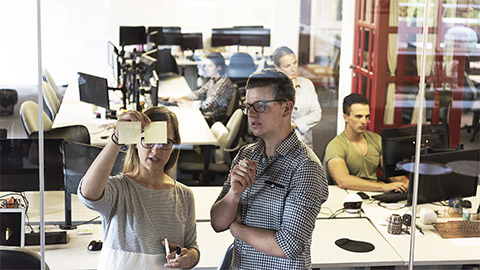Critical thinking refers to the ability to think clearly and rationally about what to do in any situation. It helps you create knowledge and evidence-based solutions to problems you can encounter in the workplace. Most, if not all, organisations see critical thinking as an essential skill because it helps save time and money in the long run.
Critical thinkers make the best decisions when it comes to communicating information and completing tasks in the workplace. They can think outside the box and use facts when dealing with problems. They are also able to weigh all the possible solutions to a problem before making a final decision.
Organisations are more likely to hire people equipped with critical thinking skills. This topic will discuss how critical thinking can be established in the workplace. It will explain the key characteristics of the critical thinking process and provide ways on how you can apply these concepts to your life. It will also discuss the benefits one can gain when applying critical thinking processes.

As discussed, critical thinking is the process of evaluating and analysing thinking. It involves effective problem-solving and communication abilities. It also involves self-disciplined and corrective thinking. While information plays a big role in the critical thinking process, critical thinking is not just about memorising information. Critical thinkers know how to use available information to their advantage. They can provide systematic solutions to problems they may encounter anywhere in the world.
Critical Thinking Processes
Critical thinking is a skill that is useful throughout your life. To improve your critical thinking skills, you must first learn about the key critical thinking processes. There are several ways to learn the key critical thinking processes. Among these methods, Bloom’s Taxonomy best describes how critical thinking processes can be used in your daily life.
Bloom’s Taxonomy
Bloom’s Taxonomy framework was developed by Benjamin Bloom in 1956. It was created to provide a common language for educators and to promote higher forms of thinking. Since its creation in 1956, Bloom’s Taxonomy has been widely used by teachers all over the world. It was also revised in 2001. The original Bloom’s Taxonomy consisted of three learning domains, namely: the cognitive, affective, and psychomotor domains. These domains were then divided into six critical thinking skills, which are presented in the pyramid below:
To gain a clearer understanding of the six skills presented in the pyramid above, refer to the explanation below:
Knowledge is the process of recalling information that can be used in presenting ideas or critical thinking tasks. This characteristic is essential in the critical thinking process because it helps you become familiar with the information you are analysing. Having prior knowledge on the subject you are discussing will help you get to the specifics of whatever you are studying. For example, you are researching about computers, and you found a site that says, ‘a computer must have a CPU and monitor’. You can look up ‘CPU’ and ‘monitor’ on the internet, but unless you know what a computer is, you will not understand what the website is discussing.
Your brain takes in information through a series of steps. You can understand whatever is being discussed by linking each piece of information given and forming a general idea out of it. When doing this, you are applying comprehension and critical thinking without even knowing it. Comprehension is the process of fully understanding what the critical thinking task or idea is communicating and having the capability to transform it into one’s own version. When you comprehend something, you begin to understand how it could be part of a whole.
This is the application of recalled knowledge to the critical thinking task or idea. Here, you can demonstrate, create, and showcase knowledge or ideas that you may have learned in the past. You can choose to apply your knowledge in various ways, such as art, writing, music, thinking. All these are ways that may help you determine where you can apply your knowledge. You may go back to the example on computers. Your organisation is tasking you to buy a new computer. By recalling your knowledge on a computer’s parts, you would know that buying a new computer would entail purchasing a monitor and a CPU. By applying your recalled knowledge on a computer’s components, you are preventing yourself from buying the wrong thing and using critical thinking in the process.
Analysis is the separation of information and comparing them with one another to identify their connection in the critical thinking task or idea. This fundamental characteristic is often needed in decision-making, particularly when you are comparing information. By analysing the information given to you, you can identify how pieces of information is related to a task and creates the best solution to a given problem.
Synthesis is the process of combining pieces of critical thinking tasks or ideas to form new meaning or interpretations. It involves sharing, discussing, and revising information or ideas. Here, the information you will be handling may involve old or new knowledge and ideas. This process is useful in critical thinking because it helps you create new ideas from readily available information. Knowing whether the information you have gathered fits together is vital to this process. Refer to the list below for a guide on how you can identify whether the information you have gathered fits together:
- Determine whether your information stays on topic. Do they all talk about the same subject?
- Determine where your information came from. You may use information obtained from credible sources or ideas you created yourself.
- Your information should have more similarities than differences.
- Your information should be objective and organised.
Evaluation is the process of making judgments on the value, credibility, or strength of thoughts and ideas. To make the best decisions, one must always remain impartial and objective. Being impartial and objective is important for evaluation so that proper judgements can be made. These judgements are determined by the person being evaluated, based on why they are evaluating the object or idea. Lastly, being impartial helps you avoid biases in decision-making and helps you weigh the pros and cons of each option before making a choice as well.
Video
The original Bloom’s Taxonomy was often used to encourage higher forms of education. It was used as a guide for educators to assess a student’s learning. It was also used to compare assessment and learning methods. While some still refer to the original Bloom’s Taxonomy, its revised counterpart is more widely used nowadays. Knowing the difference between the revised and original versions will help you understand how both methods affect mental development. The main differences between the old and new versions of Bloom’s Taxonomy are the following:
- The old version uses nouns while the revised version uses verbs.
- Taxonomic levels are slightly rearranged.
- The revised version regards creativity as the highest form of learning.
You may refer to the revised Bloom’s Taxonomy presented in the pyramid below for guidance:
This skill involves remembering facts and basic concepts. This taxonomy level is based on the first level of the old version of Bloom’s Taxonomy. Both involve remembering knowledge on previously learned information. Here, you may name, write, and describe the information you have read or heard.
Understanding involves describing, classifying, and interpreting concepts or ideas. Like the previous level, this taxonomy level is also based on the second level of the old version of Bloom’s Taxonomy. Both levels focus on constructing meaning from different sources of information.
This skill involves applying learned information to new situations. It is based on the third level of the old Bloom’s Taxonomy. Here, you can apply the knowledge you learned in classrooms, books, and even the internet, to concrete situations. You can also organise your thoughts and develop questions that may help you find answers to your problems.
Here, you will be analysing your ideas and drawing connections between them. Like the fourth level of the old Bloom’s Taxonomy, this skill allows you to differentiate your ideas from one another and distinguish their different characteristics. It differs from the previous level since it allows you to break information down into more manageable parts and relate each part to another.
Evaluating involves justifying your decision through the information and ideas you generated in the previous skills. This skill is based on the sixth level of the old version of Bloom’s Taxonomy. Both levels focus on reviewing information and making sure that it conforms to a given set of criteria. In the revised taxonomy, this skill comes before creating because it focuses on reviewing the skill before using it to create something new.
The revised Bloom’s Taxonomy refers to this skill as the highest form of learning. It focuses on creating new work or putting together learned information in a new way. This may involve organising, designing, and developing original works or processes.

As mentioned earlier, critical thinking takes time and patience. One cannot expect themselves to become critical thinkers overnight. To become a critical thinker, you must first learn about the different critical thinking techniques. Critical thinking techniques allow you to address and understand a given situation based on facts and available information. They also allow you to see the bigger picture and to piece bits of information together.
Critical thinking plays an important part in the workplace, too. It is applicable whenever people solve problems or make decisions. Each person in an organisation makes countless decisions daily. These decisions can either make or break deals, results, and agreements.
Critical Thinking Techniques and How They can be Applied in the Workplace
There are four critical thinking techniques:
Asking questions
Asking questions is an important part of critical thinking. It helps you recall and interpret facts and break down and judge information. When asking questions, it is important to:
- Ask open-ended questions: Asking open-ended questions will enable you to obtain more information from whoever you are talking to. It will also enable you to gain a deeper understanding of your topic and will give you access to more detailed information. Finally, it will help you connect concepts together and will help you open up to different perspectives.
- Ask focused questions: Asking focused questions will help you define terms, recall facts, and organise data. It will also help you obtain more targeted answers, such as specific concepts or facts.
- Ask follow-up questions when answers are not clear: Not everyone is going to satisfactorily answer your questions the first time you ask them. Because of this, you must always remember to ask follow-up questions. Asking follow-up questions will help you elaborate and clarify details.
Considering the perspectives of others
Everyone has their own opinions about a certain topic or experience. To gain a clearer understanding of what is happening in your workplace, always ensure to ask the thoughts and opinions of the people you work with.
Doing so will help you create better and more creative solutions to your selected workplace problem. It will also help you promote communication and respect in your workplace. To do this, you may hold meetings, conferences, or you can simply converse with them one by one.
Identifying the pros and cons of each solution
The best solutions always involve weighing the pros and cons of each option before deciding. Weighing out the pros and cons of your solutions can help you make decisions that consider both sides of the spectrum.
Predicting outcomes
Considering all the possible outcomes, factors, and scenarios can help you analyse each situation. It can help you know what to expect from each solution and will also give you ideas on what to improve based on your predicted outcomes. After determining the alternative that has the most advantages, you may then make the best decision possible.
The Main Critical Thinking Concepts
Because critical thinking has such a huge impact in the workplace, its three main critical thinking concepts merit discussion:
Clarity
Clarity is perhaps the most important critical thinking concept. It greatly affects how you communicate with each other and how you perceive things around you. Clarity ensures that ideas are well-thought-out and defined. Clarity can be achieved if the critical thinking idea is understood by other people without difficulties.
People usually make mistakes and find it hard to understand concepts and procedures when they are not clearly defined beforehand. You cannot determine if a statement is relevant or accurate if it was not stated clearly. In the same way, you cannot understand an instruction when it was not explained in a clear and cohesive manner.
This critical thinking concept is always used in the workplace. For example, new employees need to be clearly trained and taught about the organisation’s policies and procedures before they are expected to work. To avoid mistakes, information must be thoroughly conveyed, and examples must be provided. In the same way, one must also ask to obtain clarity on concepts that may seem confusing. Here are some tips that will help you communicate your thoughts and ideas clearer:
- Use simple words: Using simple words delivers your message in the shortest time possible. It helps you convey your message easier, and it helps people understand what you are saying faster. You will spend less time explaining yourself if you use plain language and get straight to the point.
- Be articulate when communicating your idea: Being articulate is important because it helps you get your point across clearly. It also helps people understand what you are saying.
- Think before you speak: Always remember to think about what you are saying before you say it. It is easy to make mistakes when you say things without thinking. Make sure to check for the validity of the information you are conveying so your message can be clearly understood by others. Clear communication can be achieved by using clear facts and evidence.
Accuracy
Accuracy is vital in critical thinking. As mentioned earlier, clear communication can be achieved by using facts and evidence. A thought conveys accuracy if it contains a precise and accurate idea. It must be backed up by facts, and those facts must conform to the truth.
For example, your organisation gave you the task to research the percentage of Australians that use computers. You cannot make up figures to address this question. To answer this question accurately, you must look for credible sources and information to deliver an accurate message.
Here are some criteria to check if the information you are conveying is accurate:
- Is it free from errors?
- Is it free from errors?
- Are the sources you used accurate?
Logicalness
Logic refers to the science of reasonable thinking based on sound judgement. It also refers to how the parts of a whole make sense together. Logicalness is present when critical thinking ideas mutually support one another. Their combination must be structured and must present facts.
When your brain processes information, it arranges a collection of thoughts together to form a cohesive idea. Thinking is logical when the combination of thoughts is structured. It must also present a relationship between facts and evidence. Thinking is not logical when the combination is contradictory and does not make sense.
You can think of your ideas as puzzle pieces. Logicalness is achieved when the puzzle pieces fit perfectly together. Ask yourself the following questions to check if your ideas are logical:
- What is your position on the matter?
- Do your ideas support your stance?
- Do your ideas make sense?
- Do your ideas fit together logically?
- Do your ideas follow the evidence you gathered?
Ensure that your ideas answer these questions correctly to make sure your ideas are consistent and logical. Inconsistent ideas may lead to confusion and misunderstandings.
Critical thinkers are people who can move beyond ‘typical’ thinking models. They are advanced thinkers who are more than capable of testing first impressions, solving problems, and making decisions based on facts and evidence.
The Critical Thinking Approaches
Critical thinkers are also capable of following the three critical thinking approaches, as stated below:
Analysis is the separating of thoughts and ideas into different parts. These parts may include an idea’s strengths and weaknesses, different possibilities, etc. To further understand this critical thinking approach, refer to this example: Your organisation sends out customer feedback forms daily. You manager will then analyse this feedback and use the information obtained to develop improvements that will cater to your customer’s needs. Analysing the feedback obtained and developing improvements may include thinking of different possibilities and studying the strengths and weaknesses of each option.
Synthesis is the combination of various thoughts and ideas to form a new coherent whole. The thoughts and ideas may include their similarities and differences to determine new interpretations.An example of this may be: Suppose you are researching on the effects social media has on businesses. After obtaining information from credible sources, you have learned the following information:
- It helps you gain more customers
- It helps you establish your brand
- It helps you obtain feedback and evaluate your performance
- It can create opportunities for criticism that may impact your business in negative ways, like creating content that may unintentionally embarrass your business, etc.
- It can create opportunities that may impact your business positively, like creating viral content, etc.
Evaluation is making judgments on the value, credibility, or strength of thoughts and ideas. Being impartial and objective is important for evaluation so that the proper judgement can be made. You may gain a better understanding of how evaluation and critical thinking go hand in hand by continuing the example provided on the effects social media has on businesses. After obtaining information on your topic, ask yourself the following questions:
- Did you obtain your information from credible sources?
- Did you consider all possible perspectives while researching on your topic?
- Do all your points connect to each other?
- Are your ideas relevant to your topic?
- Are your opinions on the topic the same before and after you researched it?
These are but a few questions you can ask to evaluate the work you have done on your topic. Always ensure to evaluate your work based on the credibility of your sources, and the content of your research.
Evaluation steps
Evaluations help you assess situations wherein critical thinking is applied. They also help you become more aware if anything needs to be improved or changed. You can evaluate situations through the following steps:
- Identify the situation you want to evaluate. The first step to evaluating situations is providing a clear description of what you want to evaluate. Here, you can also set goals for what you want to accomplish in your evaluation. Situations that can be evaluated can include evaluating how communication is practised in the workplace or how office hours are spent by employees.
- Create evaluation questions. Ensure to create evaluation questions that meet your evaluation goals. These questions should be in line with what you want to evaluate.
- Create a set of criteria to base your evaluation on. Creating a set of criteria is important because it provides a means to measure what you want to evaluate. It also helps you determine what is important to you. Furthermore, criteria should determine expectations and should provide structure to your evaluation.
- Collect data. Here, you must collect accurate and reliable data that will answer your evaluation question. You must also determine how you want to conduct your evaluation. You can conduct your evaluation through surveys, testimonials, pre and post tests and grades.
- Analyse and communicate results. Analysing results involves organising your data and reviewing its quality and consistency. Here, you must determine how your results are related to each other, and you must also describe how you handled your results. This step involves sharing your findings and identifying recommendations. Always ensure to clearly present your results so they can be easily understood by others. You can communicate your results through written reports, informational videos and visual aids.
From the steps discussed, it is evident that evaluations need to be done to determine whether your goals were achieved or if improvements need to be made in your workplace.

Now that you know the key characteristics and concepts behind critical thinking, the benefits one can gain by thinking critically in the workplace will now be discussed. Critical thinking in the workplace can affect people through the decisions you make.
Applying critical thinking practices in the workplace has many benefits:
- It encourages you to observe different situations and weigh all possible results before making a decision. Critical thinking can help you create better decisions. As mentioned before, the best decisions always involve weighing the pros and cons of each option before deciding. Considering all the possible results, factors, and scenarios can help you analyse each situation. After determining the alternative that has the most advantages, you may then make the best decision.
- It looks beyond a specific step in the decision-making process. Another benefit of applying critical thinking practices in the workplace includes looking towards the future when making decisions. Critical thinkers do not just focus on the information or the steps provided. Instead, they look beyond what is provided and think of ways on how each step can be improved.
Example:
Suppose you are working for an organisation that specialises in doing scientific research. You are given an outline of the topic you will be assigned to do research on. However, after reading through it, you realised that a lot of information was missing and that you could achieve better results by doing extra research on the topic. Doing more than what is expected of you is a benefit of applying critical thinking processes because it helps you gain an in-depth understanding of your task. It also helps you achieve better results and promotes hard work and perseverance in the workplace.- It brings new ideas to the table and promotes creativity. Critical thinking makes you think outside the box and go beyond your comfort zone. It also helps you create more creative approaches to a variety of scenarios. This includes imagining possibilities, connecting ideas, and applying these ideas by generating solutions. Creativity will always be useful in critical thinking. This is because critical thinking deals with generating ideas, weighing alternatives, and making decisions.
- It helps you move past the familiar or routine. When gathering your thoughts and making decisions, the first things one usually thinks of usually lean towards the familiar or routine. By applying critical thinking to the decision-making process, you learn to think of new solutions to old problems. You will not be stuck classifying anything under something that has happened in the past.
Quiz
